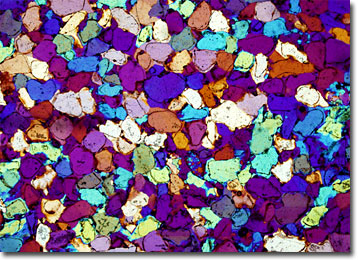Polarized Light Microscopy Digital Image Gallery
Red Sandstone
Sandstone is a common sedimentary rock primarily composed of grains of sand cemented together by various materials, such as clay, calcium carbonate, silica, or iron oxides. In its purest state, sandstone is white in color, but the material is more typically seen in hues of brown, yellow, and red.

Comprising as much as 20 percent of the Earth’s crust, sandstones are of significant scientific interest and are frequently utilized as indicators of various geologic processes, such as erosion. The rocks are more generally used, however, as a construction material and appear as basic components in a large number of buildings throughout the world. Red sandstone, for instance, was particularly popular in central England before industrialization and the invention of the train made it easier to import heavy materials from other areas due to the region's proximity to a thick sequence of Devonian rocks called Old Red Sandstone and a similar layer of rocks formed in the Triassic period classically referred to as New Red Sandstone. In some locations, however, such as southern Africa, red sandstone has been more often utilized for carvings and other artistic purposes.
Red sandstone, which is especially known for its great beauty in the western United States, often forms spectacular vistas and natural structures that serve as tourist attractions. Large red sandstone monoliths that jut out from the Earth towards the sky, for example, can be seen at various national landmarks and parks, such as the Garden of the Gods, a 1,350-acre park located in Colorado Springs, Colorado. Also, eons of wind and running water have carved out stunning sandstone canyons and winding mazes in many locales, including southern Utah where the breathtaking Bryce Canyon National Park is located. Hundreds of thousands of visitors partake of these and other geologically sculpted red sandstone wonders each year.
